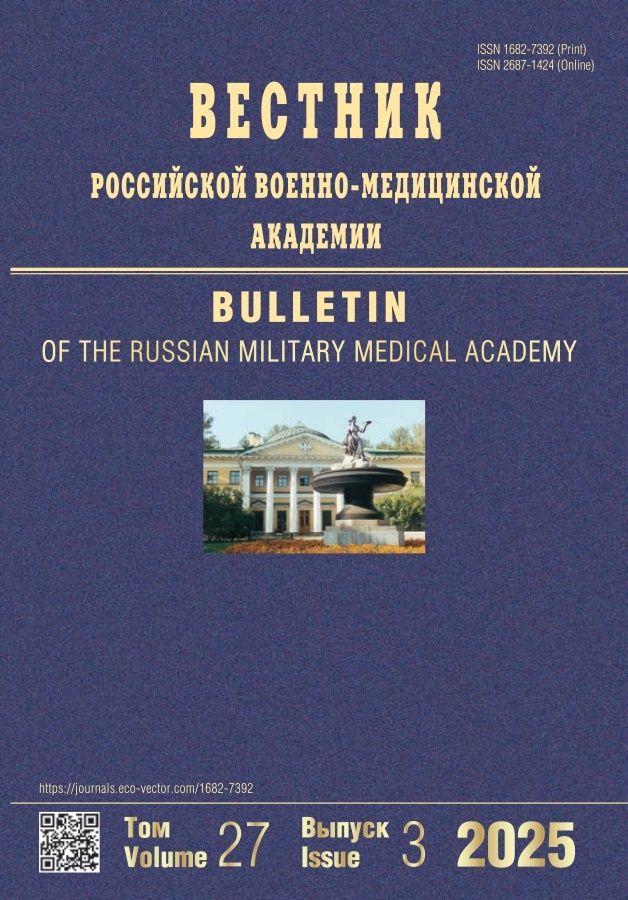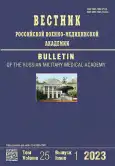Особенности функционирования системы медицинского снабжения войск (сил) в ходе операции по принуждению Грузии к миру в Южной Осетии (7–12 августа 2008 г.)
- Авторы: Мирошниченко Ю.В.1, Перфильев А.Б.1, Овчинников Д.В.1, Костенко Н.Л.1, Бережнов Р.П.2
-
Учреждения:
- Военно-медицинская академия имени С.М. Кирова
- 639-й Центр обеспечения медицинской техникой и имуществом
- Выпуск: Том 25, № 1 (2023)
- Страницы: 59-70
- Раздел: Оригинальное исследование
- URL: https://journals.rcsi.science/1682-7392/article/view/134087
- DOI: https://doi.org/10.17816/brmma192502
- ID: 134087
Цитировать
Аннотация
Представлена деятельность по обеспечению медицинским имуществом войск (сил), участвовавших в операции по принуждению Грузии к миру в Южной Осетии (7–12 августа 2008 г.). Показаны особенности функционирования учреждений и подразделений медицинского снабжения накануне и после вторжения воинских контингентов Грузии в Южную Осетию. Изложена хронология деятельности подразделений и учреждений медицинского снабжения в зоне боевых действий. Выявлены особенности обеспечения войск (сил) лекарственными средствами и препаратами крови, дезинфицирующими средствами, а также изделиями медицинского назначения. Определен порядок закупки, путей доставки и создания резерва наиболее востребованного медицинского имущества, а также отправки и ремонта подвижной медицинской техники при подготовке к операции и в ходе боевых действий. Установлено, что благодаря профессионализму специалистов медицинской службы Вооруженных сил Российской Федерации на всех уровнях военного здравоохранения была оперативно создана группировка сил и средств, включавшая подразделения и учреждения медицинского снабжения. Указаны проблемные вопросы функционирования системы медицинского снабжения войск (сил) с учетом негативного влияния объективных и субъективных факторов, а также дана характеристика мерам по ее оптимизации на основе опыта медицинского обеспечения войск (сил) в ходе операции по принуждению Грузии к миру. Отражены результаты реализации научно-исследовательских и опытно-конструкторских работ по совершенствованию нормативной правовой базы, касающейся вопросов использования наркотических средств и психотропных веществ в условиях боевых действий и создания современных образцов комплектно-табельного оснащения: аптечек, сумок медицинских, комплектов медицинского имущества, а также наборов медицинских и укладок. В целом накопленный опыт организации обеспечения медицинским имуществом войск (сил) в ходе операции по принуждению Грузии к миру в Южной Осетии позволил задействованным учреждениям и подразделениям медицинского снабжения успешно справиться с поставленными задачами. Специалисты медицинского снабжения всех уровней военного здравоохранения самоотверженно выполняли свои профессиональные обязанности. Благодаря их усилиям военно-медицинские организации, соединения и воинские части были практически полностью обеспечены медицинским имуществом, что способствовало своевременному и полному оказанию медицинской помощи и лечению раненых (пострадавших).
Полный текст
Открыть статью на сайте журналаОб авторах
Юрий Владимирович Мирошниченко
Военно-медицинская академия имени С.М. Кирова
Email: miryv61@gmail.com
ORCID iD: 0000-0002-3645-2071
SPIN-код: 9723-1148
Scopus Author ID: 25643218200
доктор фармацевтических наук, профессор
Россия, Санкт-ПетербургАлександр Борисович Перфильев
Военно-медицинская академия имени С.М. Кирова
Автор, ответственный за переписку.
Email: alex_perfilev@mail.ru
ORCID iD: 0000-0002-9947-1296
SPIN-код: 6843-2803
Scopus Author ID: 56181413400
кандидат фармацевтических наук
Россия, Санкт-ПетербургДмитрий Валерьевич Овчинников
Военно-медицинская академия имени С.М. Кирова
Email: alex_perfilev@mail.ru
ORCID iD: 0000-0001-8408-5301
SPIN-код: 5437-3457
Scopus Author ID: 57521789500
канд. мед. наук, доцент
Россия, Санкт-ПетербургНаталья Леонидовна Костенко
Военно-медицинская академия имени С.М. Кирова
Email: kostenkonl@yandex.ru
Scopus Author ID: 55050898500
кандидат фармацевтических наук, доцент
Россия, Санкт-ПетербургРоман Петрович Бережнов
639-й Центр обеспечения медицинской техникой и имуществом
Email: bereg21vek@mail.ru
SPIN-код: 9842-4310
руководитель центра
Россия, СевастопольСписок литературы
- Тришкин Д.В., Фисун А.Я., Крюков Е.В., Вертий Б.Д. Военная медицина и современные войны: опыт истории и прогнозы, что ждать и к чему готовиться // Сборник статей III Всероссийской научно-технической конференции: «Состояние и перспективы развития современной науки по направлению «Биотехнические системы и технологии». Анапа, 2021. С. 8–16.
- Цыганок А.Д. Война 08.08.08. Принуждение Грузии к миру. Москва: Вече, 2011. 288 с.
- Калачёв О.В., Крюков Е.В., Крайнюков П.Е., и др. Обеспечение готовности медицинской службы Вооруженных сил к работе в условиях гибридной войны // Военно-медицинский журнал. 2021. Т. 342, № 12. С. 15–22. doi: 10.52424/00269050_2021_342_12_15
- Корнюшко И.Г., Бояринцев В.В., Амбражук И.И., Яковлев С.В. Организация медицинского обеспечения войск в ходе операции по принуждению Грузии к миру // Военно-медицинский журнал. 2009. Т. 330, № 2. С. 4–6. doi: 10.17816/RMMJ72481
- Фисун А.Я., Самохвалов И.М., Гончаров А.В., и др. Пути снижения летальности в современной гибридной войне: раненого к хирургу или хирургию к раненому? // Военно-медицинский журнал. 2020. Т. 341, № 1. С. 20–29. doi: 10.17816/RMMJ82221
- Мирошниченко Ю.В., Беня Ф.М., Горячев А.Б. Опыт медицинского снабжения войск в вооруженном конфликте на территории Южной Осетии // Военно-медицинский журнал. 2009. Т. 330, № 1. С. 68–72. doi: 10.17816/RMMJ72436
- Котенко П.К., Пак Р.В., Головинова В.Ю. Движение легкораненых и легкобольных в военных госпиталях в ходе операции по принуждению Республики Грузия к миру (август 2008 г.) // Военно-медицинский журнал. 2014. Т. 335, № 9. С. 14–19. doi: 10.17816/RMMJ74261
- Самохвалов И.М. Проблемы организации оказания хирургической помощи раненым в современной войне: хирургическая помощь на этапах медицинской эвакуации (сообщение первое) // Военно-медицинский журнал. 2012. Т. 333, № 12. С. 4–11. doi: 10.17816/RMMJ74669
- Самохвалов И.М., Котенко П.К., Северин В.В. Проблемы организации оказания хирургической помощи раненым в современной войне: оказание медицинской помощи и лечение легкораненых в вооруженном конфликте (сообщение второе) // Военно-медицинский журнал. 2013. Т. 334, № 1. С. 4–8. doi: 10.17816/RMMJ74269
- Мирошниченко Ю.В., Горячев А.Б. Организация использования наркотических и психотропных лекарственных средств в воинских частях Вооруженных сил РФ при ведении боевых действий // Вестник Росздравнадзора. 2012. № 4. С. 40–44.
- Мирошниченко Ю.В., Бунин С.А., Голубенко Р.А., и др. Итоги и перспективы научного сопровождения совершенствования системы медицинского снабжения войск (сил) // Вестник Российской военно-медицинской академии. 2014. № 2. С. 248–256.
- Мирошниченко Ю.В., Миляев А.В., Ступников А.В. Становление системы комплектно-табельного оснащения войскового звена медицинской службы Вооруженных сил Российской Федерации и ее модернизация в современных условиях // Вестник Росздравнадзора. 2011. № 3. С. 48–54.
- Тюрин М.В., Сохранов М.В., Ивченко Е.В., и др. Совершенствование оказания медицинской помощи при боевых действиях: мониторинг физиологического состояния военнослужащего // Военно-медицинский журнал. 2014. Т. 335, № 1. С. 45–47.
- Мирошниченко Ю.В., Ивченко Е.В., Кононов В.Н., и др. Перспективные направления инновационного развития фармации в военном здравоохранении России // Вестник Российской военно-медицинской академии. 2022. Т. 24, № 1. С. 179–188. doi: 10.17816/brmma101106
Дополнительные файлы














